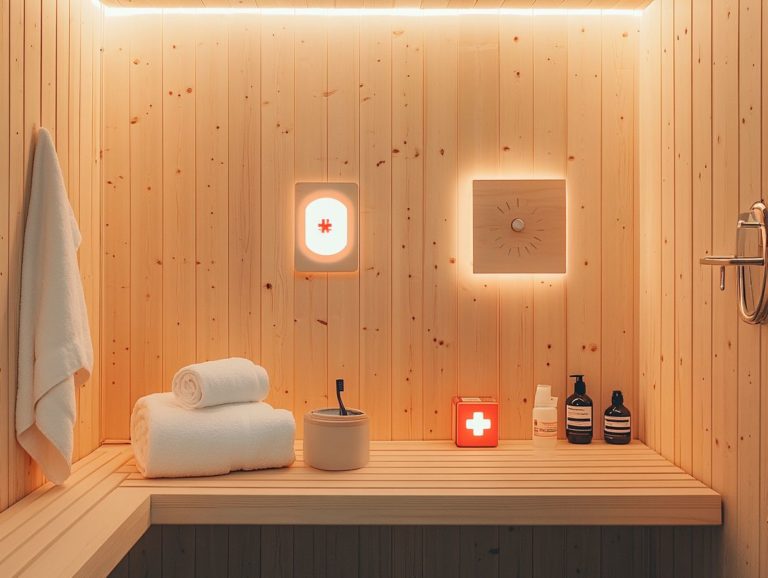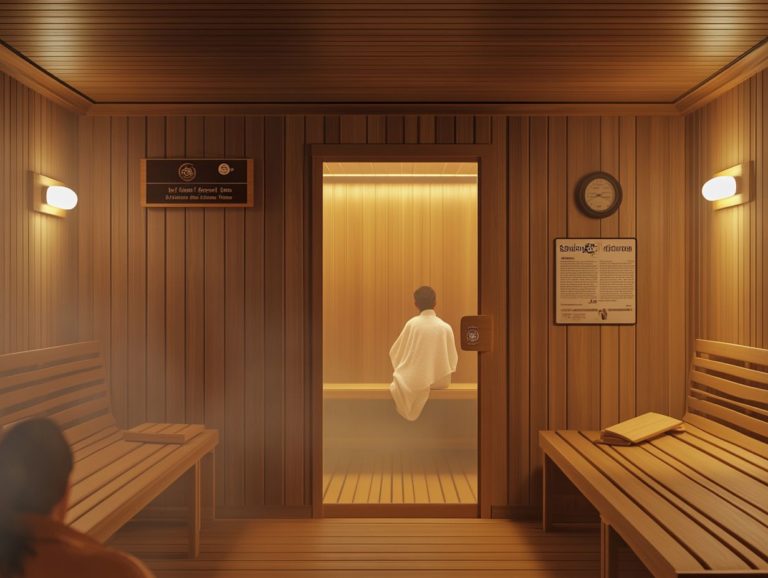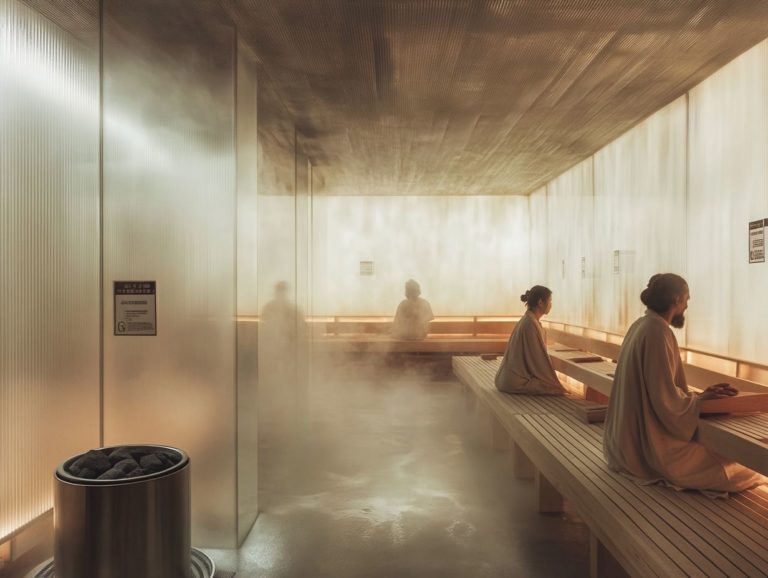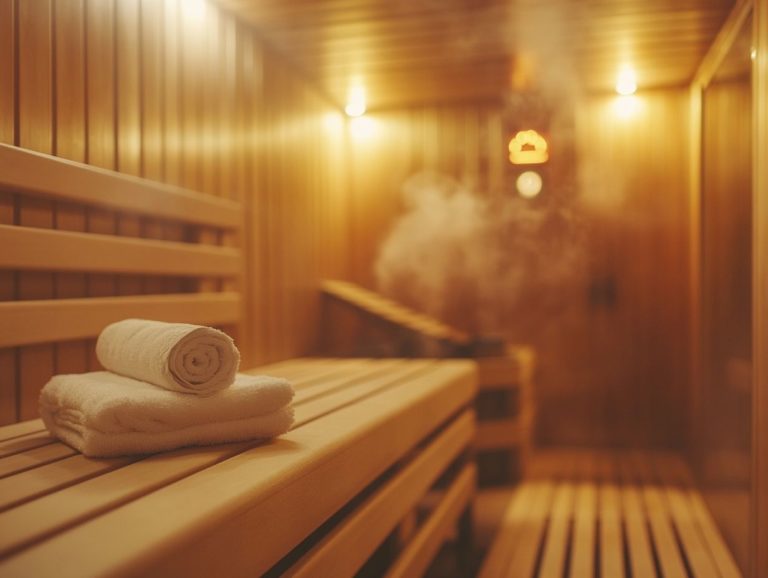Tips for Safe Sauna Use in Public Facilities
Saunas seamlessly combine relaxation and health benefits, making them a cherished element of many wellness routines.
Engaging in this time-honored practice does require some thoughtful considerations, particularly in public facilities.
This article delves into the myriad benefits and potential risks of sauna use, equipping you with essential tips on what to bring, what to wear, and how to uphold proper hygiene and etiquette.
Experience amazing relaxation that will leave you feeling rejuvenated! You’ll discover safe temperature practices, recognize the signs of overheating, and explore aftercare strategies to enhance your sauna experience.
For those who value privacy, at-home sauna alternatives offer an appealing option. Immerse yourself in this guide to ensure your sauna sessions are both pleasurable and safe!
Contents
- Key Takeaways:
- Benefits and Risks of Sauna Use
- Preparing for Sauna Use
- Safety Precautions in Public Saunas
- Using the Sauna Safely
- After Sauna Care
- Alternatives to Public Saunas
- Frequently Asked Questions
- What are some general tips for safe sauna use in public facilities?
- Can I use the sauna if I have a medical condition?
- How long should I stay in the sauna?
- What should I bring with me to the sauna?
- Are there any safety precautions I should take while using the sauna?
- What should I do after using the sauna?
Key Takeaways:
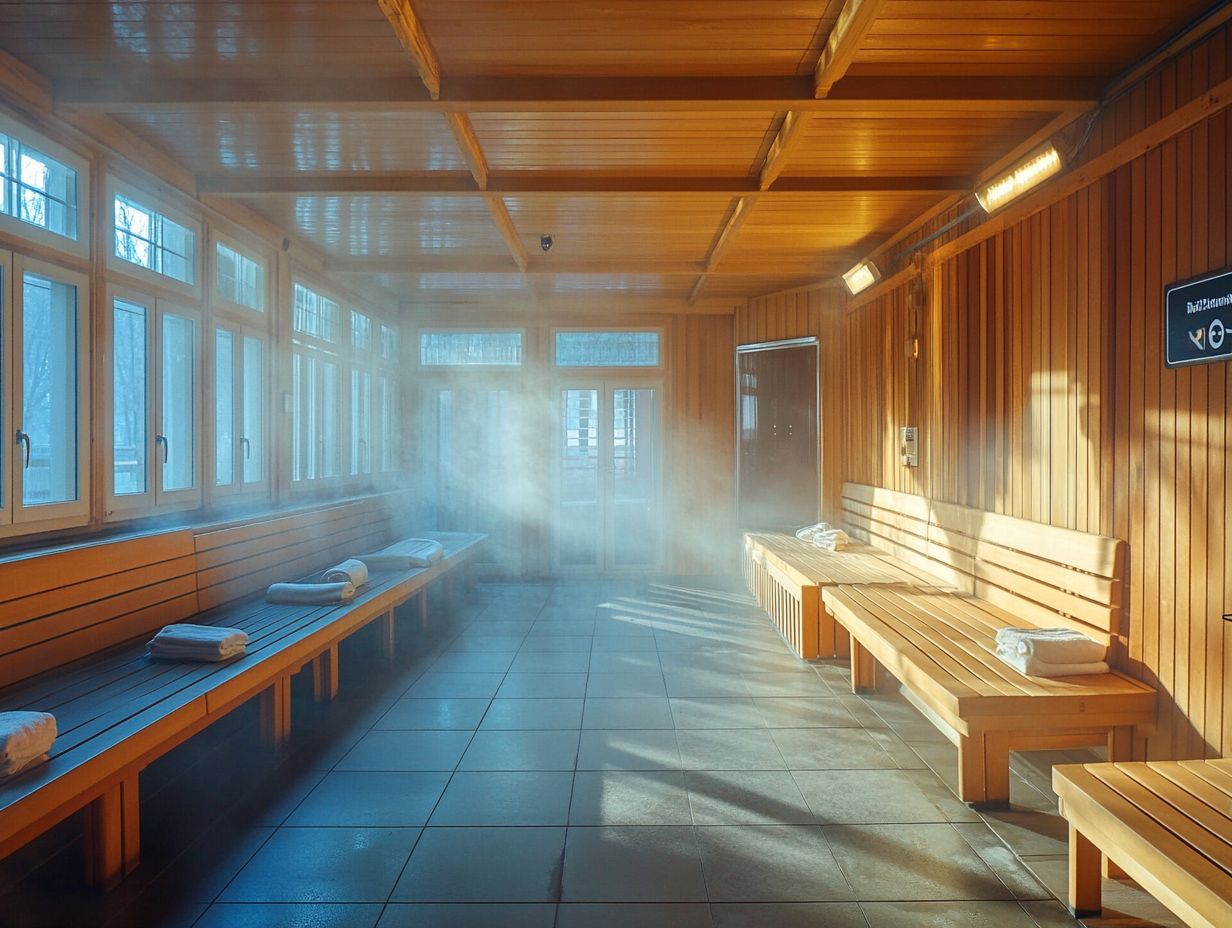
- Prepare right: Bring a towel and water to ensure a safe sauna experience!
- Always follow safety precautions while using a public sauna, such as maintaining proper hygiene and respecting other users’ space.
- To avoid overheating, use the sauna for no more than 15-20 minutes and keep the temperature below 194 F. Stay hydrated and cool down properly after your session.
Benefits and Risks of Sauna Use
Using a sauna, especially a traditional Finnish sauna, presents a wealth of health benefits. You can experience enhanced relaxation, improved circulation, and significant stress reduction, making it an alluring option for those seeking to unwind after a demanding day. Sauna experiences vary greatly, emphasizing the importance of understanding different sauna types.
It’s crucial to be aware of the potential risks associated with improper use. Issues like dehydration, overheating, or aggravating certain health conditions can arise, highlighting the importance of knowing both the benefits and the risks that come with your sauna experience.
Preparing for Sauna Use
Preparing for your sauna experience requires a bit of thought about what to bring and wear, ensuring that every moment is both comfortable and enjoyable. This preparation can differ based on whether you re visiting a public sauna, such as a steam bath or a Turkish bath, or enjoying the privacy of your own infrared sauna at home.
Typically, you’ll want to gather essentials such as a large towel, water to stay hydrated, and suitable swimwear or clothing that promotes ease of movement and comfort in the warm atmosphere.
What to Bring and Wear
When preparing for a sauna session, consider what to bring and wear to elevate your experience and uphold sauna etiquette. Pack a large towel to sit on, a smaller one for drying off, flip-flops for hygiene, and always bring water to stay hydrated. Depending on the sauna culture and your personal comfort level, light, breathable clothing or even nudity may be the way to go, especially in steam rooms or when using heated rocks.
You might also think about bringing a personal sauna mat for added comfort, especially in public settings where cleanliness is a priority. If nudity isn t your thing, a well-chosen swimsuit can provide a comfortable alternative, ensuring you enjoy the experience without overheating.
It s crucial to embrace the unwritten rules of sauna etiquette:
- Always shower before entering.
- Avoid bringing electronic devices.
- Keep conversations soft and respectful in shared spaces.
Understanding these practices can significantly enhance your experience and that of your fellow bathers, fostering a peaceful and relaxing atmosphere for everyone involved, whether in a dry sauna or a Finnish sauna.
Safety Precautions in Public Saunas
Safety first! Enjoying a sauna in public is a shared experience, so let’s keep it clean and comfortable for everyone! Safety precautions are essential for ensuring an enjoyable experience for all bathers. Emphasizing personal hygiene and adherence to sauna etiquette, including guidelines on sauna usage and cleanliness, is key.
You should shower before entering the sauna, respect the personal space of others, and observe temperature guidelines, especially when in a wood-lined sauna or other types of sauna facilities. This not only fosters an inviting atmosphere for everyone but also minimizes the risk of spreading bacteria or causing discomfort among users.
Proper Hygiene and Etiquette
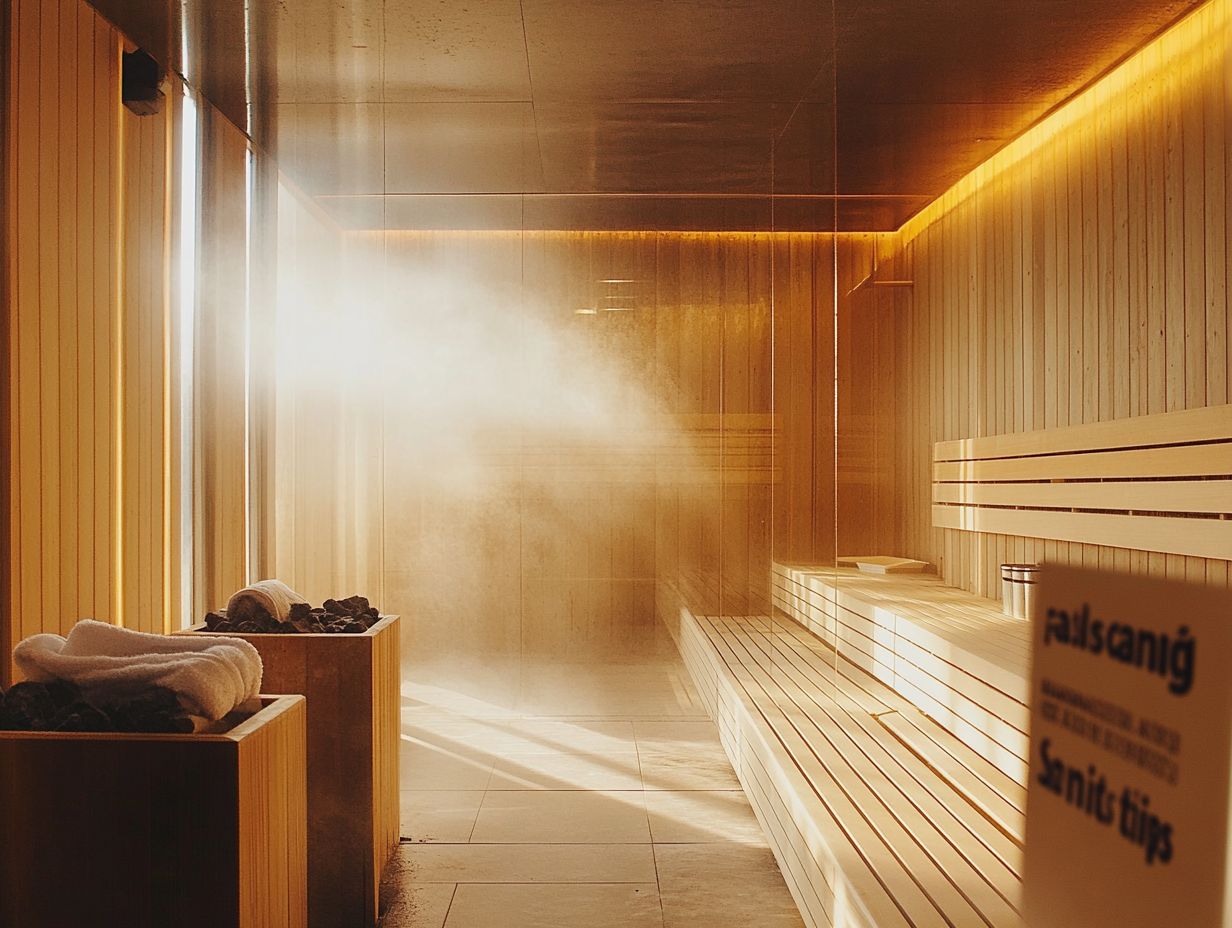
Proper hygiene and sauna etiquette is crucial for improving your public sauna experience, ensuring you and your fellow bathers can enjoy the benefits without discomfort or health concerns. Key practices include showering thoroughly before entering the sauna, using a towel to sit on, and keeping conversations to a minimum to create a peaceful atmosphere.
Rinsing off completely is vital to wash away sweat and dirt, contributing to a cleaner atmosphere for everyone. In terms of sauna attire, opting for designated swimwear or a light towel demonstrates respect for those around you. As a newcomer, watching others can give you great tips on sauna behavior, such as maintaining personal space and avoiding boisterous conversations. By being mindful of your surroundings and limiting mobile phone usage, you help foster a tranquil environment, transforming the sauna into a revitalizing retreat for all.
Using the Sauna Safely
Using the sauna safely requires following established temperature guidelines and understanding recommended time limits. This way, you can fully enjoy the health benefits of your sauna experience while minimizing risks. For example, a typical Finnish sauna operates at higher temperatures, usually ranging from 150 F to 195 F. To prevent overheating, limit your time to 15-20 minutes per session, ensuring you reap the rewards without compromising your well-being.
Recommended Time and Temperature
When you indulge in a sauna, paying attention to recommended time and temperature is crucial for maximizing the experience while ensuring safety. A typical dry sauna or Finnish sauna is best set between 150 F and 195 F, and it’s wise to limit your sessions to 15-20 minutes to avoid overheating.
Steam baths or steam rooms operate at a moderate range of 110 F to 120 F, where you can enjoy them for about 20-30 minutes for optimal relaxation and skin hydration. Infrared saunas, known for their ability to penetrate deeper into the skin at temperatures of 120 F to 150 F, can be utilized for 30-45 minutes.
Each type provides unique health benefits, such as improved circulation and detoxification, which means removing toxins from your body, as well as stress relief. However, it s essential to be in tune with your comfort levels, adjusting duration and temperature based on how you feel.
Listening to your body is key, as everyone s tolerance varies. By prioritizing your well-being over the clock, you can truly elevate your sauna experience.
Signs of Overheating and How to React
Recognizing the signs of overheating is essential for ensuring a safe and enjoyable experience. Common symptoms include dizziness, nausea, excessive sweating, and an accelerated heart rate. If you notice any of these, take immediate action to cool down and rehydrate.
Pay attention to how you feel; when discomfort sets in, calmly step out of the sauna. Once outside, cooling down becomes a priority. Seek out a shaded area or apply cool water to your skin to help regulate your temperature. Hydration is equally important drink water or a sports drink to replenish lost fluids and electrolytes.
By taking these steps, you not only reduce the risks associated with overheating but also elevate your overall sauna experience, making it a truly revitalizing one! Follow these tips for a safe and refreshing sauna experience!
After Sauna Care
After your sauna session, prioritize care to enhance the health benefits you ve just experienced. Focus on proper hydration with water or electrolyte-rich beverages.
Drink plenty of water to help your body gradually return to its normal temperature. This approach avoids adverse effects from heat exposure and maximizes your sauna experience.
Hydration and Cooling Down
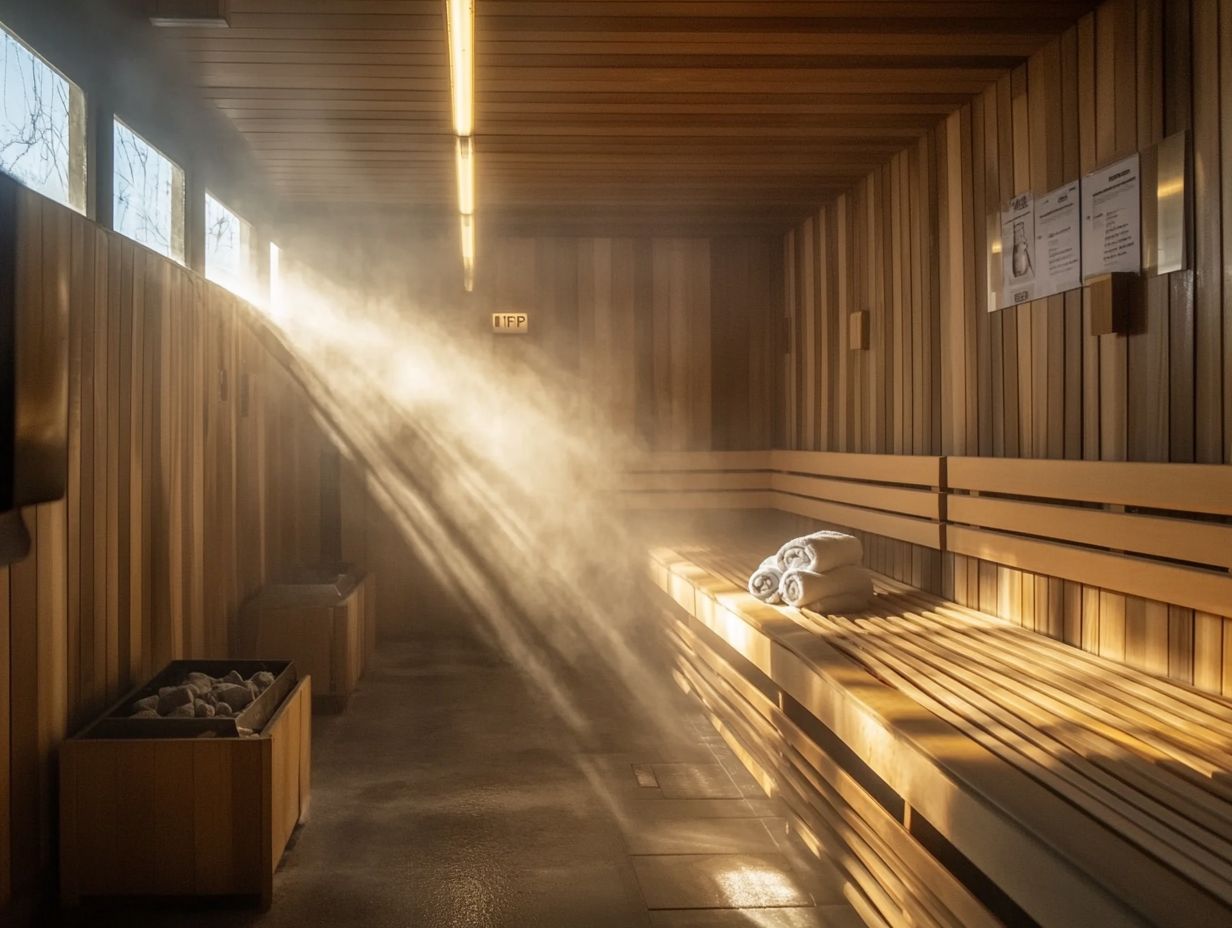
Hydration and cooling down are key for post-sauna care. They allow you to enjoy your sauna benefits while minimizing health risks.
Drink water or electrolyte-rich beverages after your session to replace lost fluids and restore the right amount of minerals in your body. Gradually cool your body to prevent shock from sudden temperature changes.
Aim to consume at least 16 to 24 ounces of fluid for every hour you spend in the sauna. Options like coconut water and sports drinks provide essential minerals.
For cooling down, step into a lukewarm shower after using a steam bath or sauna. You can also apply a cool compress to pulse points to lower your body temperature without overwhelming your system.
Listen to your body during this process. If you feel dizzy or uncomfortable, pause and allow time for comfortable adjustment. This promotes your well-being and enhances the therapeutic effects of the sauna.
Alternatives to Public Saunas
If you re exploring alternatives to public saunas, at-home sauna options provide a convenient and private opportunity to enjoy health benefits like relaxation and improved circulation.
Infrared saunas have grown popular due to their lower temperatures while still delivering therapeutic effects. They are a great choice for home installations.
At-Home Sauna Options
At-home sauna options give you the flexibility and convenience to enjoy sauna benefits without public facility limitations. Infrared saunas are appealing for their compact size and effective relaxation at lower temperatures.
Traditional Finnish saunas offer a more authentic experience but require careful construction and ongoing maintenance.
Steam saunas enhance hydration and skin health with high humidity. Each sauna type requires consideration of space needs, electrical requirements, and potential installation costs.
If you choose to go the Do-It-Yourself route, select proper materials for insulation and heat retention to ensure safety and efficiency.
Regular maintenance is also important. Perform cleaning and monitor humidity to avoid mold and structural issues.
By considering these factors, you can create a personalized and enjoyable sauna experience right at home.
Frequently Asked Questions
What are some general tips for safe sauna use in public facilities?
Stay hydrated, follow the recommended time limits, and avoid alcohol before entering the sauna.
Can I use the sauna if I have a medical condition?

If you have a medical condition, consult your doctor before using a sauna. Follow your doctor’s recommendations for safe sauna use.
How long should I stay in the sauna?
The recommended sauna time is usually 10-15 minutes. Listen to your body; exit if you feel discomfort or lightheadedness.
What should I bring with me to the sauna?
Don t forget to bring your favorite towel for comfort! You should also pack a water bottle to stay refreshed during your session.
Are there any safety precautions I should take while using the sauna?
Yes! Avoid touching hot surfaces directly with your skin. Also, skip oils or lotions, and don t use the sauna if you re pregnant or have heart issues.
What should I do after using the sauna?
Cool down gradually after your sauna experience. A cool shower or stepping outside into fresh air works best.
Remember to rehydrate after sweating. It s essential for feeling great!

